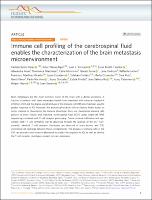| dc.contributor | Vall d'Hebron Barcelona Hospital Campus |
| dc.contributor.author | Rubio Pérez, Carlota |
| dc.contributor.author | Planas Rigol, Ester |
| dc.contributor.author | Trincado, Juan L. |
| dc.contributor.author | Bonfill Teixidor, Ester |
| dc.contributor.author | Arias Piñeiro, Alexandra |
| dc.contributor.author | Marchese, Domenica |
| dc.contributor.author | Iurlaro, Raffaella |
| dc.contributor.author | Martínez Ricarte, Francisco Ramón |
| dc.contributor.author | Escudero Monreal, Laura |
| dc.contributor.author | Cordero Asanza, Esteban Xavier |
| dc.contributor.author | Cicuendez López Ocaña, Marta |
| dc.contributor.author | Nuciforo, Paolo Giovanni |
| dc.contributor.author | Sahuquillo Barris, Joan |
| dc.contributor.author | Tabernero Caturla, Josep |
| dc.contributor.author | Seoane Suarez, Joan |
| dc.contributor.author | Serna, Garazi |
| dc.date.accessioned | 2021-07-15T12:22:26Z |
| dc.date.available | 2021-07-15T12:22:26Z |
| dc.date.issued | 2021-03-08 |
| dc.identifier.citation | Rubio-Perez C, Planas-Rigol E, Trincado JL, Bonfill-Teixidor E, Arias A, Marchese D, et al. Immune cell profiling of the cerebrospinal fluid enables the characterization of the brain metastasis microenvironment. Nat Commun. 2021 Mar 8;12(1):1503. |
| dc.identifier.issn | 2041-1723 |
| dc.identifier.uri | https://hdl.handle.net/11351/6171 |
| dc.description | Cancer microenvironment; Tumour immunology |
| dc.description.abstract | Brain metastases are the most common tumor of the brain with a dismal prognosis. A fraction of patients with brain metastasis benefit from treatment with immune checkpoint inhibitors (ICI) and the degree and phenotype of the immune cell infiltration has been used to predict response to ICI. However, the anatomical location of brain lesions limits access to tumor material to characterize the immune phenotype. Here, we characterize immune cells present in brain lesions and matched cerebrospinal fluid (CSF) using single-cell RNA sequencing combined with T cell receptor genotyping. Tumor immune infiltration and specifically CD8+ T cell infiltration can be discerned through the analysis of the CSF. Consistently, identical T cell receptor clonotypes are detected in brain lesions and CSF, confirming cell exchange between these compartments. The analysis of immune cells of the CSF can provide a non-invasive alternative to predict the response to ICI, as well as identify the T cell receptor clonotypes present in brain metastasis. |
| dc.language.iso | eng |
| dc.publisher | Nature Research |
| dc.relation.ispartofseries | Nature Communications;12(1) |
| dc.rights | Attribution 4.0 International |
| dc.rights.uri | http://creativecommons.org/licenses/by/4.0/ |
| dc.source | Scientia |
| dc.subject | Cervell - Tumors |
| dc.subject | Càncer - Immunoteràpia |
| dc.subject | Metàstasi |
| dc.subject.mesh | Brain Neoplasms |
| dc.subject.mesh | Antineoplastic Agents, Immunological |
| dc.subject.mesh | Neoplasm Metastasis |
| dc.title | Immune cell profiling of the cerebrospinal fluid enables the characterization of the brain metastasis microenvironment |
| dc.type | info:eu-repo/semantics/article |
| dc.identifier.doi | 10.1038/s41467-021-21789-x |
| dc.subject.decs | neoplasias cerebrales |
| dc.subject.decs | inmunoterapia antineoplásica |
| dc.subject.decs | metástasis neoplásica |
| dc.relation.publishversion | https://www.nature.com/articles/s41467-021-21789-x |
| dc.type.version | info:eu-repo/semantics/publishedVersion |
| dc.audience | Professionals |
| dc.contributor.organismes | Institut Català de la Salut |
| dc.contributor.authoraffiliation | [Rubio-Perez C, Planas-Rigol E, Bonfill-Teixidor E, Arias A, Serna G, Iurlaro R, Escudero L, Nuciforo P] Vall d’Hebron Institute of Oncology (VHIO), Barcelona, Spain. Vall d’Hebron Hospital Universitari, Barcelona, Spain. [Trincado JL] CNAG-CRG, Centre for Genomic Regulation (CRG), Barcelona Institute of Science and Technology (BIST), Barcelona, Spain. Josep Carreras Leukemia Research Institute and Department of Biomedicine, School of Medicine, University of Barcelona, Barcelona, Spain. [Marchese D] CNAG-CRG, Centre for Genomic Regulation (CRG), Barcelona Institute of Science and Technology (BIST), Barcelona, Spain. [Martínez-Ricarte F, Cordero E, Cicuendez M, Sahuquillo J] Vall d’Hebron Institut de Recerca (VHIR), Vall d’Hebron Hospital Universitari, Barcelona, Spain. Universitat Autònoma de Barcelona, Bellaterra, Spain. [Tabernero J] Vall d’Hebron Institute of Oncology (VHIO), Barcelona, Spain. Vall d’Hebron Hospital Universitari, Barcelona, Spain. Universitat Autònoma de Barcelona, Bellaterra, Spain. CIBERONC, Barcelona, Spain. [Seoane J] Vall d’Hebron Institute of Oncology (VHIO), Barcelona, Spain. Vall d’Hebron Hospital Universitari, Barcelona, Spain. Universitat Autònoma de Barcelona, Bellaterra, Spain. CIBERONC, Barcelona, Spain. Institució Catalana de Recerca i Estudis Avançats (ICREA), Barcelona, Spain |
| dc.identifier.pmid | 33686071 |
| dc.identifier.wos | 000627442600001 |
| dc.relation.projectid | info:eu-repo/grantAgreement/ES/PE2013-2016/PI16%2F01278 |
| dc.relation.projectid | info:eu-repo/grantAgreement/ES/PE2013-2016/SAF2017-89109-P |
| dc.rights.accessrights | info:eu-repo/semantics/openAccess |

